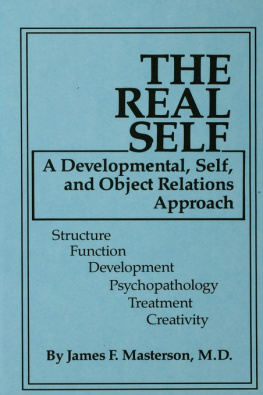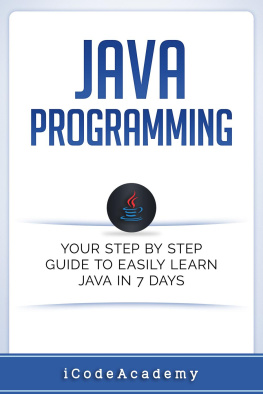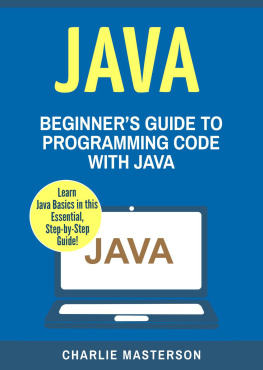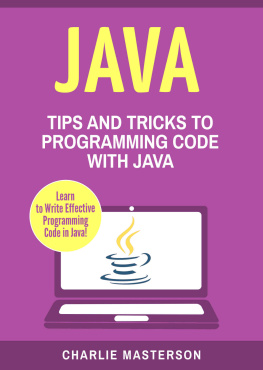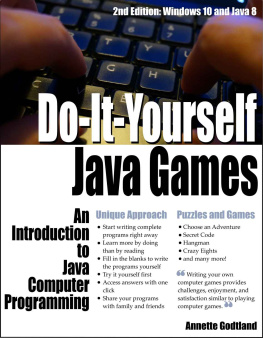Masterson - Java: Best Practices to Programming Code with Java
Here you can read online Masterson - Java: Best Practices to Programming Code with Java full text of the book (entire story) in english for free. Download pdf and epub, get meaning, cover and reviews about this ebook. year: 2017, genre: Computer. Description of the work, (preface) as well as reviews are available. Best literature library LitArk.com created for fans of good reading and offers a wide selection of genres:
Romance novel
Science fiction
Adventure
Detective
Science
History
Home and family
Prose
Art
Politics
Computer
Non-fiction
Religion
Business
Children
Humor
Choose a favorite category and find really read worthwhile books. Enjoy immersion in the world of imagination, feel the emotions of the characters or learn something new for yourself, make an fascinating discovery.
Java: Best Practices to Programming Code with Java: summary, description and annotation
We offer to read an annotation, description, summary or preface (depends on what the author of the book "Java: Best Practices to Programming Code with Java" wrote himself). If you haven't found the necessary information about the book — write in the comments, we will try to find it.
Java: Best Practices to Programming Code with Java — read online for free the complete book (whole text) full work
Below is the text of the book, divided by pages. System saving the place of the last page read, allows you to conveniently read the book "Java: Best Practices to Programming Code with Java" online for free, without having to search again every time where you left off. Put a bookmark, and you can go to the page where you finished reading at any time.
Font size:
Interval:
Bookmark:
Java: Best Practices
to Programming Code
with Java
Charlie Masterson
Table of Contents Copyright 2017 by Charlie Masterson - All rights reserved. The contents of this book may not be reproduced, duplicated or transmitted without direct written permission from the author. Under no circumstances will any legal responsibility or blame be held against the publisher for any reparation, damages, or monetary loss due to the information herein, either directly or indirectly. Legal Notice: This book is copyright protected. This is only for personal use. You cannot amend, distribute, sell, use, quote or paraphrase any part or the content within this book without the consent of the author.
Disclaimer Notice: Please note the information contained within this document is for educational and entertainment purposes only. Every attempt has been made to provide accurate, up to date and reliable complete information. No warranties of any kind are expressed or implied. Readers acknowledge that the author is not engaging in the rendering of legal, financial, medical or professional advice. The content of this book has been derived from various sources. Please consult a licensed professional before attempting any techniques outlined in this book.
By reading this document, the reader agrees that under no circumstances are is the author responsible for any losses, direct or indirect, which are incurred as a result of the use of information contained within this document, including, but not limited to, errors, omissions, or inaccuracies.
Introduction I want to thank you and congratulate you for reading mybook , Java: Best Practices to Programming Code with Java . This book contains proven steps and strategies on how to write Java code that does n t kick up errors, is neat and tidy and has a high level of readability. If your code looks familiar, it will be far easier to understand and even easier to cast your eye over to see if there are any obvious errors. To make sure your code looks familiar, there are a set of best practice guidelines that you should follow; not only will this help you, it will help other developers who look over your code as well. This book assumes that you already have a level of familiarity and experience with Java computer programming language.
My aim is to help you further your knowledge and have you programming like a pro in no time at all. If you are a completely new to the language, please familiarize yourself with the basics before you run through my best practice guide. Thanks again for purchasing this book, I hope you enjoy it!
Formatting Your Code
If you set your tabs to 4 and your file is shared with a person that has theirs set to 8 it is all going to look a mess. When you use matching braces, they must vertically line up under their construct, in exactly the same column. For example: void foo() { while (bar > 0) { System.out.println(); bar--; } if (Cheese == tasty) { System.out.println("Cheese is good and it is good for you"); } else if (Cheese == yuck) { System.out.println("Cheese tastes like rubber"); } else { System.out.println("please tell me, what is this cheesel'"); } switch (yuckyFactor) { case 1: System.out.println("This is yucky"); break; case 2: System.out.println("This is really yucky"); break; case 3: System.out.println("This is seriously yucky"); break; default: System.out.println("whatever"); break; } } Use Braces for Al l if, fo r an d whil e Statements This is the case even if they are controlling just a single statement. Why? Because when you keep your formatting consistent, your code becomes much easier to read. Not only that, if you need to add or take away lines of code, there isnt so much editing to do. Have a look at this example the first three show you the wrong way while the fourth shows the right way to do it: Bad Examples: if (superHero == theTock) System.out.println("Fork!"); if (superHero == theTock) System.out.println("Fork!"); if (superHero == theTock) { System.out.println("Fork!"); } Good Example: if (superHero == thetock) { System.out.println("Fork!"); } Spacing Whenever you have a method name, it should be followed immediately with a left parenthesis: Bad Example: foo (i, j); Good Example: foo(i, j); A left square bracket must follow immediately after any array dereference: Bad Example: args [0]; Good Example: args[0]; Make sure there is a space on either side of any binary operator: Bad Examples: a=b+c; a = b+c; a=b + c; Good Example: a = b + c; Bad Example: z = 2*x + 3*y; Good Examples: z = 2 * x + 3 * y; ! z = (2 * x) + (3 * y);! Whenever you use a unary operator it should be followed immediately by its operand: Bad Example: count ++; Good Example: count++; Bad Example: i --; Good Example: i--; Whenever you use a semicolon or a comma, follow it immediately with a whitespace: Bad Example: for (int i = 0;i < 10;i++) Good Example: for (int i = 0; i < 10; i++) Bad Example: getOmelets(EggsQuantity,butterQuantity); Good Example: getOmelets(EggsQuantity, butterQuantity); Write all casts without spaces Bad Examples: (MyClass) v.get(3); ( MyClass )v.get(3); Good Example: (MyClass)v.get(3); When you use the keyword s while, if, for, catc h an d switc h , always follow them with a space: Bad Example: if(hungry) Good Example: if (hungry) Bad Example: while(omelets < 7) Good Example: while (omelets < 7) Bad Example: for(int i = 0; i < 10; i++) Good Example: for (int i = 0; i < 10; i++) Bad Example: catch(TooManyOmeletsException e) Good Example: catch (TooManyOmeletsException e) Ordering of Class Members When you use class members, they must always be ordered in the following way, without exception: class Order { // fields (attributes) // constructors // methods } Line Length Try not to make any lines more than 120 characters long.
This is because most text editors can handle this line length easily; any more than this and things start to get a little messy and frustrating. If you find that your code is being indented way off to the right, think about breaking it done into a few more methods. Parentheses When you use parentheses in expressions, dont just use them for the precedence order; they should also be used as a way of simplifying things
Chapter 2:
Naming Conventions Naming methods, variables, and classes correctly are very important in Java and here are some of the more common conventions that, if you learn and follow, will help your code to be much clearer:
- When you are naming packages, the name should be lowercase, for example, mypackage
- All names that are representative of types have to be nouns and they are written in mixed case, beginning with an upper-case letter, for example, AudioSystem, Line
- All variable names have to be in a mixed case and start with a lower-case letter, for example , audioSystem, lin e . This makes it easier to distinguish the variables from types and also resolves any potential naming clashes.
- Where a name is representative of a constant, or a final variable, they must be in upper case and an underscore should be used separate each word, for example , COLOR_BLUE, SAM_ITERATION S . Generally, use of these constants should be kept to a minimum and, more often than not, it is better to implement a value as a method , for example
Font size:
Interval:
Bookmark:
Similar books «Java: Best Practices to Programming Code with Java»
Look at similar books to Java: Best Practices to Programming Code with Java. We have selected literature similar in name and meaning in the hope of providing readers with more options to find new, interesting, not yet read works.
Discussion, reviews of the book Java: Best Practices to Programming Code with Java and just readers' own opinions. Leave your comments, write what you think about the work, its meaning or the main characters. Specify what exactly you liked and what you didn't like, and why you think so.





